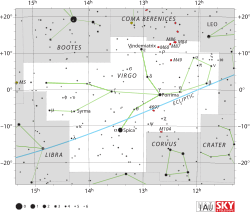Iota Virginis

| |
| Observation data Epoch J2000.0 Equinox J2000.0 | |
|---|---|
| Constellation | Virgo |
| Right ascension | 14h 16m 00.9s |
| Declination | −6° 00′ 02″ |
| Apparent magnitude (V) | +4.07[1] |
| Absolute magnitude (V) | +2.44[2] |
| Distance | 69.8 ± 1.3 ly (21.4 ± 0.4 pc) |
| Spectral type | F7 III[3] |
| Other designations | |
| Database references | |
| SIMBAD | data |
Iota Virginis (ι Virginis, abbreviated Iota Vir, ι Vir), also named Syrma,[4] is a star in the constellation of Virgo.
Nomenclature
ι Virginis (Latinised to Iota Virginis) is the star's Bayer designation.
It bore the traditional name Syrma, derived from the Arabic سرما (تطريز sirmā "train (of a garment)".[5] In 2016, the International Astronomical Union organized a Working Group on Star Names (WGSN)[6][7][8] to catalogue and standardize proper names for stars. The WGSN approved the name Syrma for this star on 12 September 2016 and it is now so entered in the IAU Catalog of Star Names.[4]
In China, 亢宿 (Kàng Xiù), meaning Neck, refers to an asterism consisting of this star, Kappa Virginis, Phi Virginis and Lambda Virginis.[9] Consequently, Iota Virginis itself is known as 亢宿二 (Kàngsuèr, English: the Second Star of Neck.)
Properties
Iota Virginis is a yellow star of apparent magnitude 4.08 and spectral class F7 III about 70 light years from Earth. This star has 1.52 times the mass of the Sun,[10] with a projected rotational velocity of 14.8 km s−1.[2] It is radiating 8.6 times the luminosity of the Sun from its outer atmosphere at an effective temperature of 6,282 K.[1] The radius is about 2.5 times that of the Sun.[11]
References
- 1 2 Mallik, Sushma V. (December 1999), "Lithium abundance and mass", Astronomy and Astrophysics, 352: 495–507, Bibcode:1999A&A...352..495M
- 1 2 Pizzolato, N.; Maggio, A.; Sciortino, S. (September 2000), "Evolution of X-ray activity of 1-3 Msun late-type stars in early post-main-sequence phases", Astronomy and Astrophysics, 361: 614–628, Bibcode:2000A&A...361..614P
- ↑ Gray, R. O.; Napier, M. G.; Winkler, L. I. (2001). "The Physical Basis of Luminosity Classification in the Late A-, F-, and Early G-Type Stars. I. Precise Spectral Types for 372 Stars". The Astronomical Journal. 121 (4): 2148. Bibcode:2001AJ....121.2148G. doi:10.1086/319956.
- 1 2 "IAU Catalog of Star Names". Retrieved 28 July 2016.
- ↑ Allen, R. H., (1963). Star Names: Their Lore and Meaning (Reprint ed.). New York, NY: Dover Publications Inc. p. 472. ISBN 0-486-21079-0.
- ↑ IAU Working Group on Star Names (WGSN), International Astronomical Union, retrieved 22 May 2016.
- ↑ IAU Formally Approves 227 Star Names, International Astronomical Union, retrieved 24 November 2016.
- ↑ NAMING STARS: List of IAU-approved Star Names as of 24.11.2016, International Astronomical Union, retrieved 24 November 2016.
- ↑ (Chinese) AEEA (Activities of Exhibition and Education in Astronomy) 天文教育資訊網 2006 年 6 月 28 日
- ↑ Shaya, Ed J.; Olling, Rob P. (January 2011), "Very Wide Binaries and Other Comoving Stellar Companions: A Bayesian Analysis of the Hipparcos Catalogue", The Astrophysical Journal Supplement, 192 (1): 2, arXiv:1007.0425
 , Bibcode:2011ApJS..192....2S, doi:10.1088/0067-0049/192/1/2
, Bibcode:2011ApJS..192....2S, doi:10.1088/0067-0049/192/1/2 - ↑ Malagnini, M. L.; Morossi, C. (November 1990), "Accurate absolute luminosities, effective temperatures, radii, masses and surface gravities for a selected sample of field stars", Astronomy and Astrophysics Supplement Series, 85 (3): 1015–1019, Bibcode:1990A&AS...85.1015M